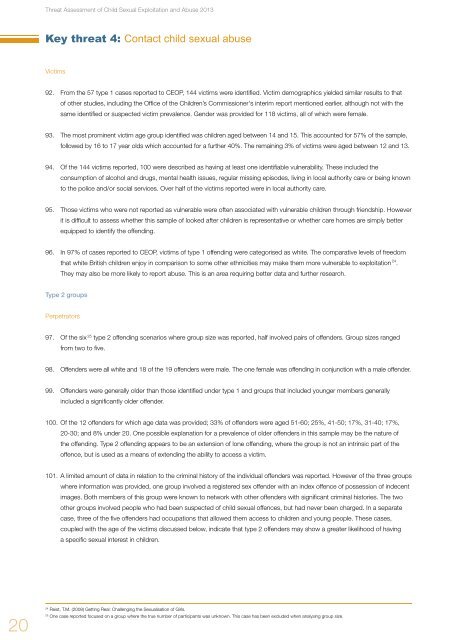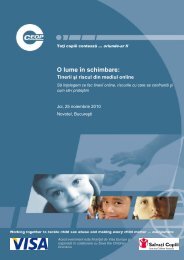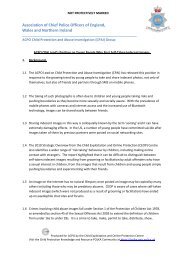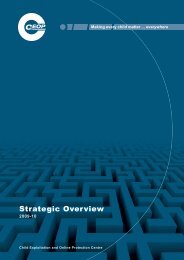Threat Assessment of Child Sexual Exploitation and Abuse - Ceop
Threat Assessment of Child Sexual Exploitation and Abuse - Ceop
Threat Assessment of Child Sexual Exploitation and Abuse - Ceop
You also want an ePaper? Increase the reach of your titles
YUMPU automatically turns print PDFs into web optimized ePapers that Google loves.
<strong>Threat</strong> <strong>Assessment</strong> <strong>of</strong> <strong>Child</strong> <strong>Sexual</strong> <strong>Exploitation</strong> <strong>and</strong> <strong>Abuse</strong> 2013<br />
Key threat 4: Contact child sexual abuse<br />
Victims<br />
92. From the 57 type 1 cases reported to CEOP, 144 victims were identified. Victim demographics yielded similar results to that<br />
<strong>of</strong> other studies, including the Office <strong>of</strong> the <strong>Child</strong>ren’s Commissioner's interim report mentioned earlier, although not with the<br />
same identified or suspected victim prevalence. Gender was provided for 118 victims, all <strong>of</strong> which were female.<br />
93. The most prominent victim age group identified was children aged between 14 <strong>and</strong> 15. This accounted for 57% <strong>of</strong> the sample,<br />
followed by 16 to 17 year olds which accounted for a further 40%. The remaining 3% <strong>of</strong> victims were aged between 12 <strong>and</strong> 13.<br />
94. Of the 144 victims reported, 100 were described as having at least one identifiable vulnerability. These included the<br />
consumption <strong>of</strong> alcohol <strong>and</strong> drugs, mental health issues, regular missing episodes, living in local authority care or being known<br />
to the police <strong>and</strong>/or social services. Over half <strong>of</strong> the victims reported were in local authority care.<br />
95. Those victims who were not reported as vulnerable were <strong>of</strong>ten associated with vulnerable children through friendship. However<br />
it is difficult to assess whether this sample <strong>of</strong> looked after children is representative or whether care homes are simply better<br />
equipped to identify the <strong>of</strong>fending.<br />
96. In 97% <strong>of</strong> cases reported to CEOP, victims <strong>of</strong> type 1 <strong>of</strong>fending were categorised as white. The comparative levels <strong>of</strong> freedom<br />
that white British children enjoy in comparison to some other ethnicities may make them more vulnerable to exploitation 24 .<br />
They may also be more likely to report abuse. This is an area requiring better data <strong>and</strong> further research.<br />
Type 2 groups<br />
Perpetrators<br />
97. Of the six 25 type 2 <strong>of</strong>fending scenarios where group size was reported, half involved pairs <strong>of</strong> <strong>of</strong>fenders. Group sizes ranged<br />
from two to five.<br />
98. Offenders were all white <strong>and</strong> 18 <strong>of</strong> the 19 <strong>of</strong>fenders were male. The one female was <strong>of</strong>fending in conjunction with a male <strong>of</strong>fender.<br />
99. Offenders were generally older than those identified under type 1 <strong>and</strong> groups that included younger members generally<br />
included a significantly older <strong>of</strong>fender.<br />
100. Of the 12 <strong>of</strong>fenders for which age data was provided; 33% <strong>of</strong> <strong>of</strong>fenders were aged 51-60; 25%, 41-50; 17%, 31-40; 17%,<br />
20-30; <strong>and</strong> 8% under 20. One possible explanation for a prevalence <strong>of</strong> older <strong>of</strong>fenders in this sample may be the nature <strong>of</strong><br />
the <strong>of</strong>fending. Type 2 <strong>of</strong>fending appears to be an extension <strong>of</strong> lone <strong>of</strong>fending, where the group is not an intrinsic part <strong>of</strong> the<br />
<strong>of</strong>fence, but is used as a means <strong>of</strong> extending the ability to access a victim.<br />
101. A limited amount <strong>of</strong> data in relation to the criminal history <strong>of</strong> the individual <strong>of</strong>fenders was reported. However <strong>of</strong> the three groups<br />
where information was provided, one group involved a registered sex <strong>of</strong>fender with an index <strong>of</strong>fence <strong>of</strong> possession <strong>of</strong> indecent<br />
images. Both members <strong>of</strong> this group were known to network with other <strong>of</strong>fenders with significant criminal histories. The two<br />
other groups involved people who had been suspected <strong>of</strong> child sexual <strong>of</strong>fences, but had never been charged. In a separate<br />
case, three <strong>of</strong> the five <strong>of</strong>fenders had occupations that allowed them access to children <strong>and</strong> young people. These cases,<br />
coupled with the age <strong>of</strong> the victims discussed below, indicate that type 2 <strong>of</strong>fenders may show a greater likelihood <strong>of</strong> having<br />
a specific sexual interest in children.<br />
20<br />
24<br />
Reist, T.M. (2008) Getting Real: Challenging the <strong>Sexual</strong>isation <strong>of</strong> Girls.<br />
25<br />
One case reported focused on a group where the true number <strong>of</strong> participants was unknown. This case has been excluded when analysing group size.











